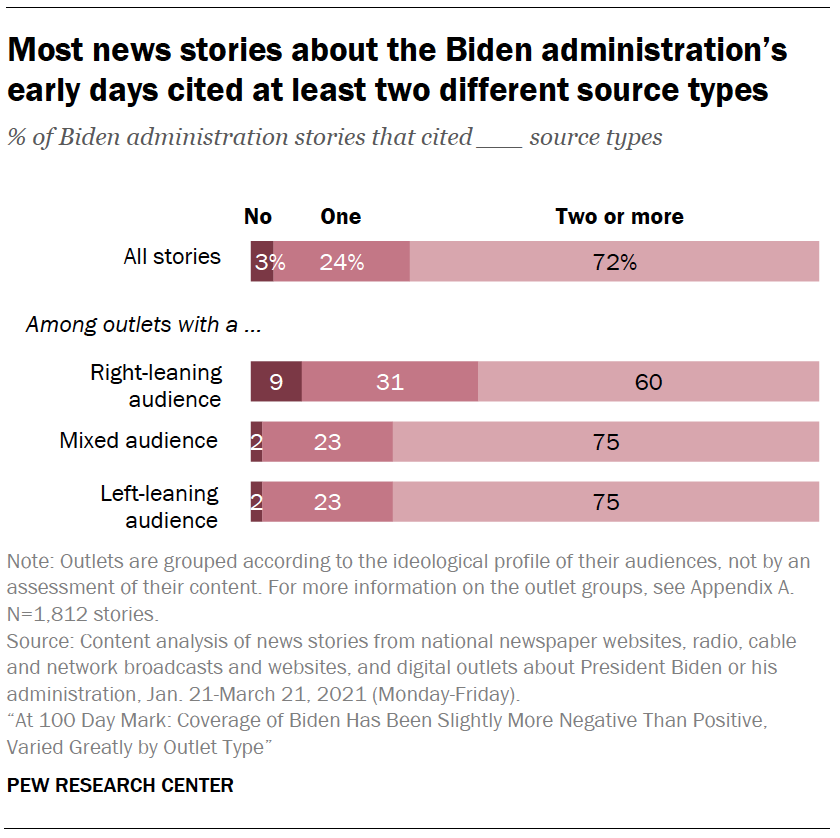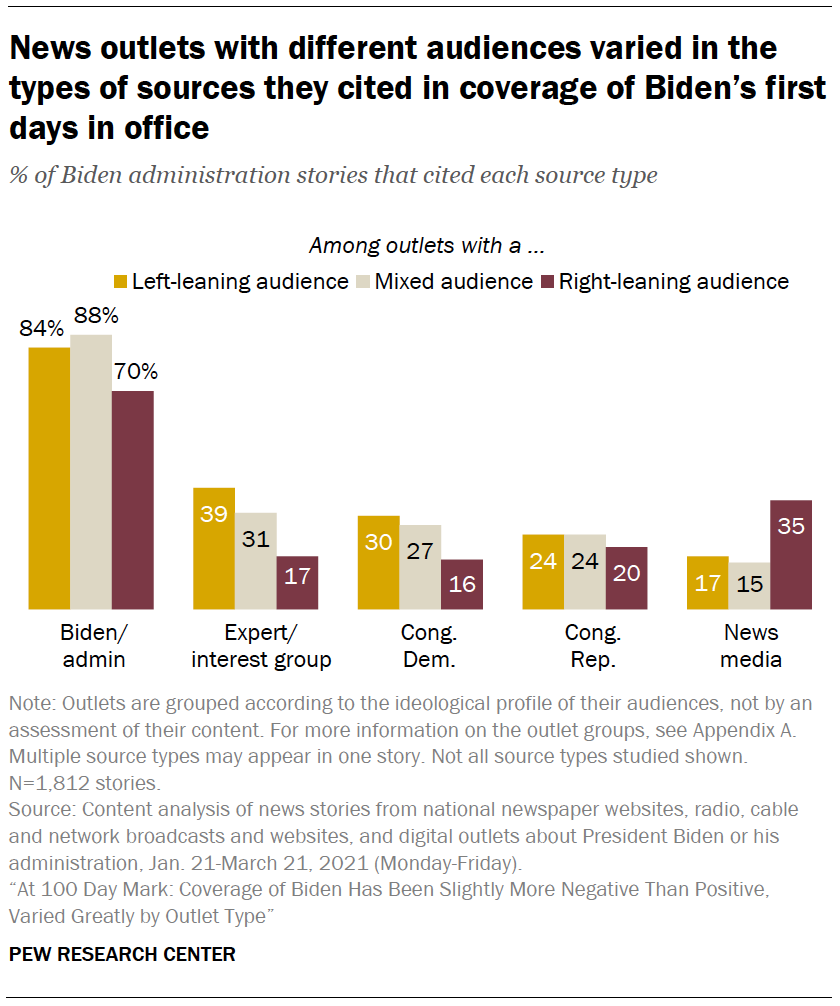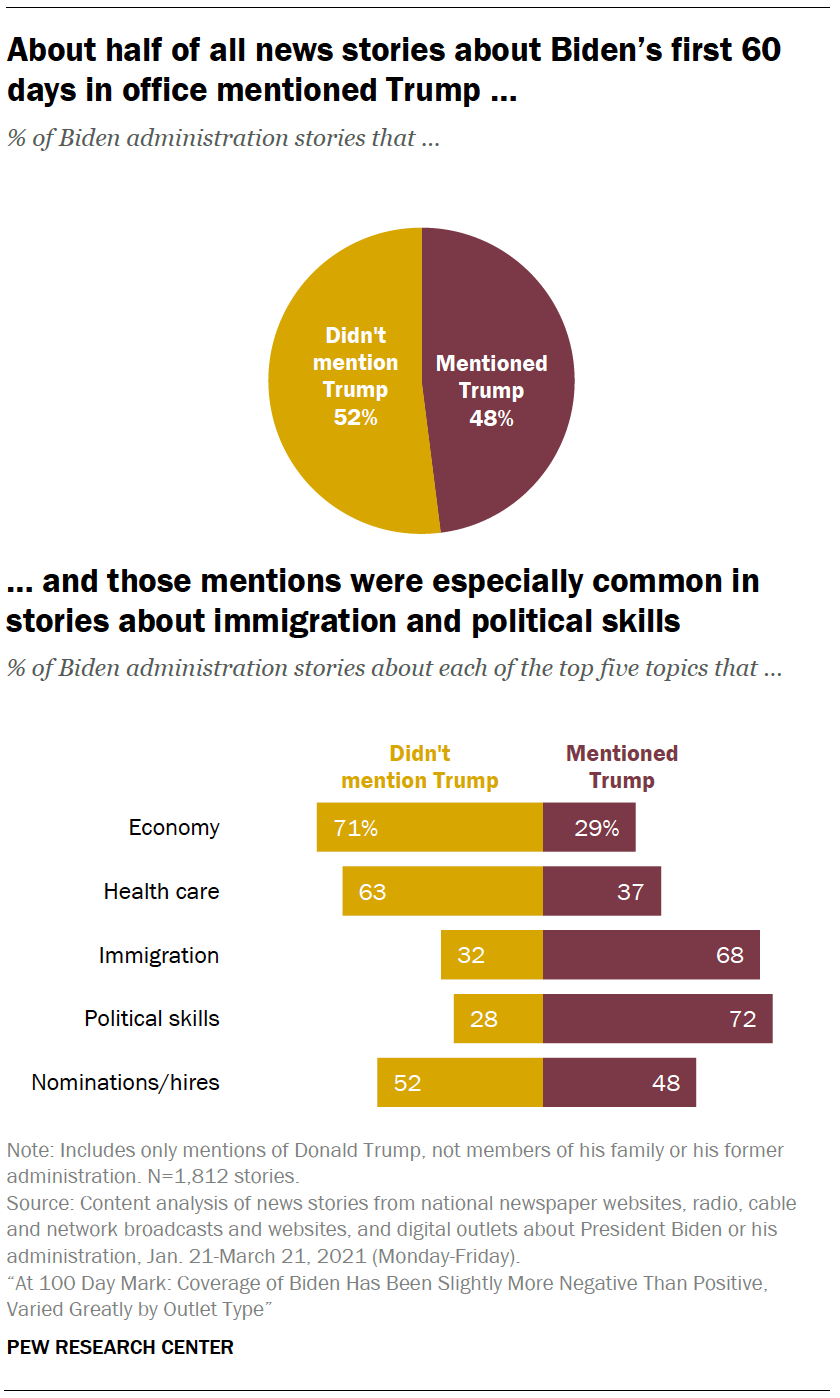 The sources journalists turn to are an important factor in any news story. Sources can affect the specific information the public receives, as well as whether the assessment of a president’s administration is positive or negative.
The sources journalists turn to are an important factor in any news story. Sources can affect the specific information the public receives, as well as whether the assessment of a president’s administration is positive or negative.
This analysis measures the presence or absence of 13 different types of sources in each news story during Biden’s first 60 days, ranging from administration officials to interest group representatives. (The full list of source types can be found here.) There could be more than one source within any source type – for example, quotes from two administration officials. At the same time, some stories may have used types of sources that are not part of this analysis.
In the early days of the Biden administration, media outlets with right-leaning audiences published fewer stories with two or more source types than outlets with left-leaning or ideologically mixed audiences.
Among outlets with right-leaning audiences, 60% of stories about the new administration included multiple source types, compared with three-quarters of stories published by outlets with left-leaning and mixed audiences (both 75%).
There was virtually no difference between left-leaning and mixed audience outlets in the number of source types they relied on. Only 2% of the stories produced by each group of outlets featured none of the source types examined, while 23% of each offered one source type.
 Among outlets with right-leaning audiences, by comparison, 9% of stories featured none of the source types examined, while roughly one-third (31%) featured one source type.
Among outlets with right-leaning audiences, by comparison, 9% of stories featured none of the source types examined, while roughly one-third (31%) featured one source type.
Biden himself, or his administration, was the most commonly cited source type. A large majority (82%) of all stories cited Biden or his administration. The next most common source type cited was far less frequent – 32% of stories cited experts or interest groups. About a quarter of stories cited congressional Democrats (27%) or congressional Republicans (23%), and one-in-five (20%) cited another news source or journalist.
Outlets with right-leaning audiences also stood out from the other two groups in some of the specific sources they included or did not include in their coverage.
In one notable example, only 17% of the stories from outlets with right-leaning audiences used sources identified as issue groups or experts. The mixed-audience outlets were roughly twice as likely to cite these types of sources (doing so in 31% of stories), and outlets with left-leaning audiences did so at an even higher rate (39% of stories).
 News outlets with right-leaning audiences were also less likely than the other two types of outlets to cite Democratic members of Congress and members of the Biden administration in their stories.
News outlets with right-leaning audiences were also less likely than the other two types of outlets to cite Democratic members of Congress and members of the Biden administration in their stories.
One type of source, however, was far more likely to appear in coverage by the right-audience outlets: journalists and media outlets other than the ones producing the story. These kinds of sources appeared in 35% of the stories published by outlets with right-leaning audiences, compared with 17% in the left-leaning audience group and 15% in the mixed-audience group.
 There were some shifts in types of sources used in Trump and Biden coverage
There were some shifts in types of sources used in Trump and Biden coverage
The total number of source types Pew Research Center measured during the early months of the Trump administration in 2017 was smaller than the number measured in 2021. As a result, the average number of source types cannot be compared directly between the two administrations. However, it is possible to compare the specific source types relied on during the early days of both administrations.
Overall, media coverage of the Biden administration was more likely to cite issue groups or experts than during Trump’s first days as president. This was the case regardless of outlet type. Issue groups or experts were cited in 39% of the stories published by outlets with left-leaning audiences in the early days of the Biden administration, up from 32% under Trump; 31% of stories from outlets with ideologically mixed audiences, up from 26%; and 17% of stories from outlets with right-leaning audiences with Biden, up from 10% in Trump’s early days.
Conversely, all three groups cited fewer journalists and other media outlets as sources in the Biden administration’s early days than under Trump. While 41% of outlets with right-leaning audiences did so in 2017, that percentage dropped to 35% this year, and among mixed-audience outlets, that number dropped from 25% during the early days of the Trump administration to 15% this year. The decrease was most dramatic among the left-leaning audience outlets (39% to 17%).
Trump mentioned in roughly half of stories about the Biden administration
 The transition between the Trump and Biden administrations was anything but traditional. Trump declined to acknowledge his electoral defeat or meet with his successor and repeatedly claimed, without evidence, that the election was stolen. Biden’s inauguration came just two weeks after a group of Trump supporters stormed the U.S. Capitol in an attempt to stop the certification of Biden’s victory.
The transition between the Trump and Biden administrations was anything but traditional. Trump declined to acknowledge his electoral defeat or meet with his successor and repeatedly claimed, without evidence, that the election was stolen. Biden’s inauguration came just two weeks after a group of Trump supporters stormed the U.S. Capitol in an attempt to stop the certification of Biden’s victory.
Given these factors, it is perhaps unsurprising that Trump was a prominent part of the media’s coverage of the first days of the Biden administration. Trump, in fact, was mentioned in about half of all stories examined in this study – with almost no differences by type of media outlet. Among outlets with left-leaning audiences, Trump was mentioned in 50% of the stories about the new administration. Outlets with right-leaning audiences and those with ideologically mixed audiences each mentioned Trump in 47% of stories.
In news stories covering Biden’s early days in office, mentions of Trump were most often associated with two topics. He appeared in 68% of stories about immigration and 72% of stories dealing with political skills and management. Trump was mentioned in about half of stories (48%) about presidential appointments and nominations and 37% of stories about health care. Among the top five topics, Trump was least likely to be mentioned in stories about the economy (29%).


